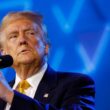China Capital Markets Witness Record Outflows in November Amidst Export Slump, Deflation Concerns, and Lingering Trump-Era Tariffs
China’s economy faced a storm of challenges in November 2024 as its capital markets saw unprecedented outflows. Official data revealed that foreign investors were pulling out in droves, amplifying concerns about the nation’s economic trajectory. Coupled with a sharp decline in exports, persistent deflationary pressures, and the continued impact of tariffs imposed during the Trump administration, these developments have raised alarms about the broader health of the Chinese economy and its global implications.

Record Outflows from Capital Markets
November witnessed foreign investors withdrawing funds at an alarming pace. The People’s Bank of China (PBOC) reported that net portfolio outflows from Chinese stocks and bonds reached $16 billion, marking the largest monthly outflow on record. Analysts attribute this trend to a combination of factors, including weaker-than-expected economic growth, geopolitical tensions, and a strengthening U.S. dollar that has made investments in China less attractive.
Foreign participation in China’s equity and bond markets has been a critical source of capital in recent years, particularly as Beijing opened its financial markets to global investors. However, the recent exodus highlights diminishing confidence in the country’s growth story. “Investors are increasingly wary of China’s structural economic issues, ranging from high debt levels to slowing productivity growth,” says Li Wei, an economist at a Shanghai-based think tank.

Export Slump and Global Trade Weakness
China’s export sector, long considered the backbone of its economy, has been hit hard by weakening global demand. In November, exports fell by 8.7% year-on-year, marking the sixth consecutive month of decline. Major trading partners, including the United States and the European Union, have scaled back imports amidst slowing economic growth and elevated inflation.
Technology exports, a critical segment of China’s trade, have been particularly affected. The U.S.-led push to restrict Chinese access to advanced semiconductor technologies and ongoing trade frictions have significantly dampened this sector. Furthermore, global supply chain diversification efforts—with countries such as Vietnam, India, and Mexico gaining prominence as alternative manufacturing hubs—have compounded the challenges for Chinese exporters.
Despite Beijing’s efforts to stabilize trade by offering tax rebates and easing export restrictions, the downward trend appears persistent. “The global economy is simply not in a position to absorb the scale of Chinese exports seen in previous years,” notes Zhang Ming, a senior trade analyst.
Deflationary Pressures Persist
Adding to the economic malaise is China’s ongoing battle with deflation. The Consumer Price Index (CPI) declined by 0.3% year-on-year in November, underscoring weak domestic demand and excess industrial capacity. Meanwhile, the Producer Price Index (PPI), which tracks factory gate prices, fell by a steeper 3.2%, extending its deflationary streak for over a year.
The deflationary environment has raised concerns about a potential “Japan-style” economic stagnation, characterized by prolonged low growth and deflation. Consumer and business confidence remain subdued despite government measures such as interest rate cuts and fiscal stimulus. High youth unemployment, aging demographics, and a debt-laden real estate sector further exacerbate the situation.
“China’s deflationary pressures are not just cyclical but structural,” warns Zhao Qian, an economist at a Beijing-based consultancy. “Without significant reforms to boost productivity and domestic consumption, the economy risks entering a prolonged period of stagnation.”

The Lingering Shadow of Trump-Era Tariffs
Compounding these economic woes is the enduring impact of tariffs imposed during the Trump administration. Despite hopes for a reset in U.S.-China trade relations under President Biden, most of the tariffs remain intact. The U.S. currently imposes duties on over $350 billion worth of Chinese goods, ranging from consumer electronics to industrial machinery.
These tariffs have not only hindered China’s export growth but have also reshaped global supply chains. Many companies have either moved production out of China or diversified their sourcing to avoid tariff-related costs. While Beijing has introduced measures to attract foreign businesses, such as easing restrictions on foreign ownership and offering tax incentives, the competitive landscape has shifted in favor of other emerging markets.
Moreover, geopolitical tensions—including the U.S. ban on Chinese tech firms like Huawei and Beijing’s countermeasures against American companies—have added another layer of complexity. “The tariffs are just one aspect of a broader decoupling trend,” says Mei Ling, a trade policy expert. “The U.S.-China economic relationship is increasingly characterized by competition rather than cooperation.”

Policy Response and Future Outlook
In response to these challenges, Chinese policymakers have rolled out a series of measures aimed at stabilizing the economy. The PBOC has lowered interest rates and reduced banks’ reserve requirements to encourage lending. Additionally, the government has unveiled infrastructure spending plans and introduced subsidies to support key industries such as green energy and advanced manufacturing.
However, these measures face limitations. For one, high levels of local government debt constrain the scope for fiscal stimulus. Furthermore, structural issues such as overcapacity in manufacturing and the need for economic rebalancing towards consumption-oriented growth require longer-term solutions.
Internationally, China is seeking to diversify its trade relationships and reduce reliance on Western markets. Initiatives like the Belt and Road Initiative (BRI) and partnerships with developing countries in Africa, Asia, and Latin America aim to create new growth avenues. Yet, these efforts will take time to yield significant results.
The immediate outlook remains clouded by uncertainties. While some analysts believe that China’s economic slowdown is a temporary adjustment, others warn of deeper systemic issues. “China is at a crossroads,” says Michael Pettis, a professor of finance at Peking University. “How it navigates these challenges will determine not only its own future but also the trajectory of the global economy.”

Global Implications of China’s Economic Woes
China’s economic struggles have far-reaching implications for the global economy. As the world’s second-largest economy and a major driver of global growth, any slowdown in China reverberates across markets. Commodity-exporting countries like Australia and Brazil are already feeling the pinch from reduced Chinese demand for raw materials. Similarly, multinational corporations with significant exposure to China—from automakers to luxury goods producers—face revenue pressures.
Moreover, China’s financial market outflows highlight broader concerns about emerging markets. As global investors reassess their risk appetite amidst rising U.S. interest rates and geopolitical uncertainties, other developing economies could face similar capital flight.
Conclusion
November 2024 stands out as a pivotal moment for China, with record capital market outflows, a deepening export slump, persistent deflation, and the lingering impact of Trump-era tariffs painting a sobering picture of the nation’s economic health. While Beijing’s policy responses aim to stabilize the situation, structural challenges and external pressures complicate the path forward. The stakes are high not just for China but for the entire global economy, which continues to grapple with the ripple effects of the world’s largest exporter and one of its most vital growth engines. The coming months will be critical in determining whether China can weather this storm or whether its economic challenges will deepen further.










